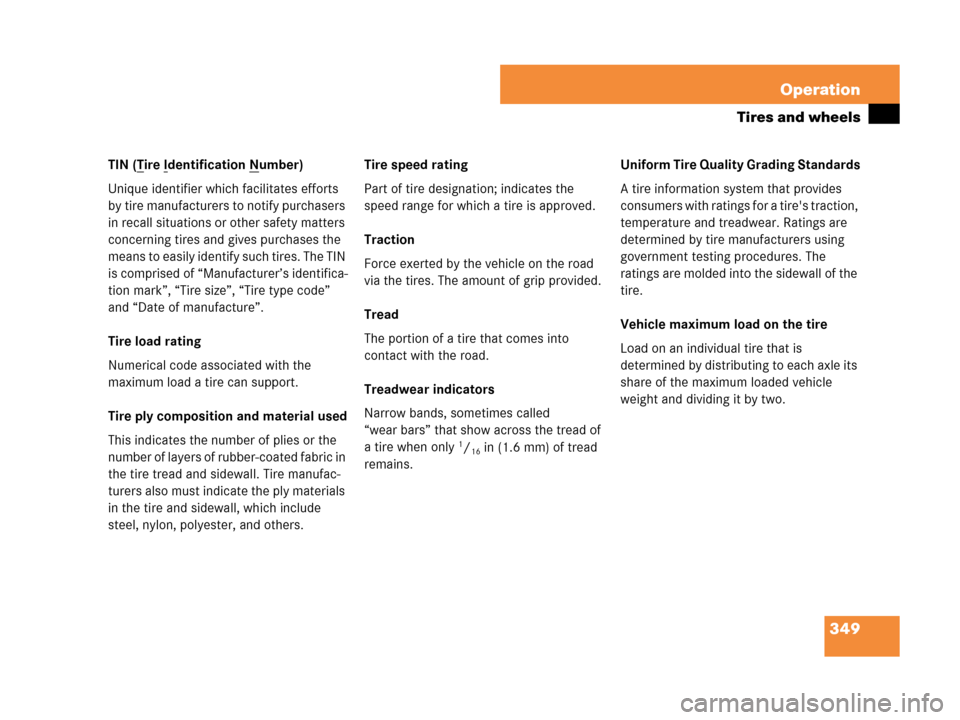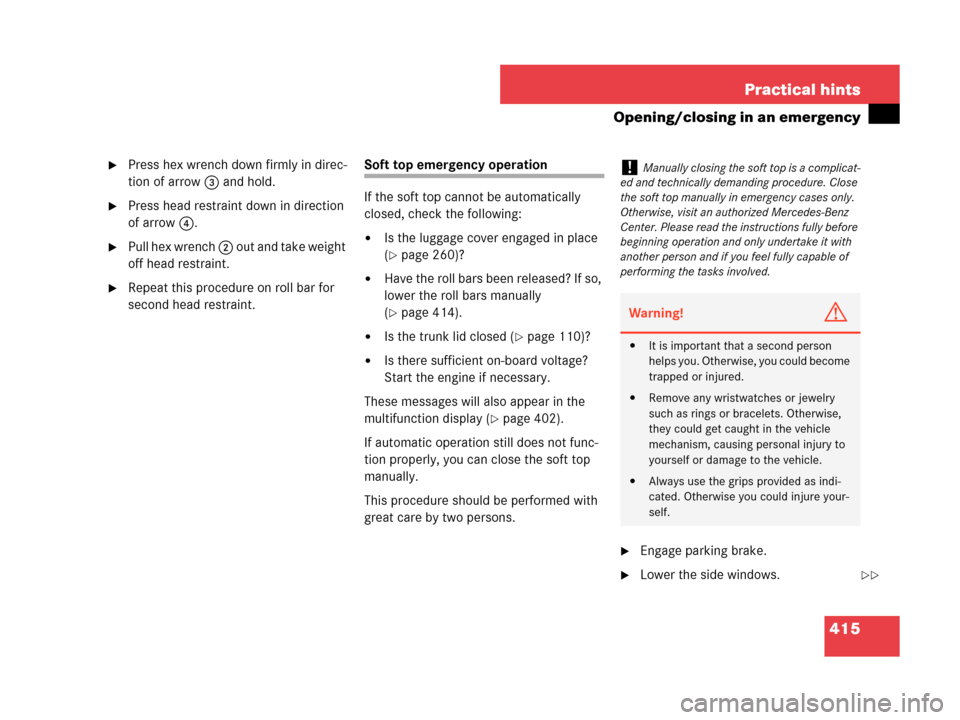Page 349 of 505

348 Operation
Tires and wheels
GVWR (Gross Vehicle Weight Rating)
This is the maximum permissible vehicle
weight of the fully loaded vehicle (weight of
the vehicle including all options, passen-
gers, fuel, and cargo and, if applicable,
trailer tongue load). It is indicated on
certification label located on the driver’s
door B-pillar.
Kilopascal (kPa)
The metric unit for air pressure. There are
6.9 kPa to 1 psi; another metric unit for air
pressure is bars. There are 100 kilopascals
(kPa) to 1 bar.
Maximum load rating
The maximum load in kilograms and
pounds that can be carried by the tire.
Maximum loaded vehicle weight
The sum of curb weight, accessory weight,
total load weight, and production options
weight.Maximum tire inflation pressure
This number is the greatest amount of air
pressure that should ever be put in the tire
under normal driving conditions.
Normal occupant weight
The number of occupants the vehicle is
designed to seat, multiplied by
68 kilograms (150 lbs).
Occupant distribution
The distribution of occupants in a vehicle
at their designated seating positions.
Production options weight
The combined weight of those installed
regular production options weighing over
5 lbs (2.3 kilograms) in excess of those
standard items which they replace, not
previously considered in curb weight or
accessory weight, including heavy duty
brakes, ride levelers, roof rack, heavy duty
battery, and special trim.PSI (Pounds per square inch)
A standard unit of measure for air pressure
-> bar, kilopascal (kPa).
Recommended tire inflation pressure
Recommended tire inflation pressure
listed on placard located on driver’s door
B-pillar for normal driving conditions.
Provides best handling, tread life and
riding comfort.
Rim
A metal support for a tire or a tire and tube
assembly upon which the tire beads are
seated.
Sidewall
The portion of a tire between the tread and
the bead.
Page 350 of 505

349 Operation
Tires and wheels
TIN (Tire Identification Number)
Unique identifier which facilitates efforts
by tire manufacturers to notify purchasers
in recall situations or other safety matters
concerning tires and gives purchases the
means to easily identify such tires. The TIN
is comprised of “Manufacturer’s identifica-
tion mark”, “Tire size”, “Tire type code”
and “Date of manufacture”.
Tire load rating
Numerical code associated with the
maximum load a tire can support.
Tire ply composition and material used
This indicates the number of plies or the
number of layers of rubber-coated fabric in
the tire tread and sidewall. Tire manufac-
turers also must indicate the ply materials
in the tire and sidewall, which include
steel, nylon, polyester, and others.Tire speed rating
Part of tire designation; indicates the
speed range for which a tire is approved.
Traction
Force exerted by the vehicle on the road
via the tires. The amount of grip provided.
Tread
The portion of a tire that comes into
contact with the road.
Treadwear indicators
Narrow bands, sometimes called
“wear bars” that show across the tread of
a tire when only
1/16in (1.6 mm) of tread
remains.Uniform Tire Quality Grading Standards
A tire information system that provides
consumers with ratings for a tire's traction,
temperature and treadwear. Ratings are
determined by tire manufacturers using
government testing procedures. The
ratings are molded into the sidewall of the
tire.
Vehicle maximum load on the tire
Load on an individual tire that is
determined by distributing to each axle its
share of the maximum loaded vehicle
weight and dividing it by two.
Page 377 of 505
376 Practical hints
What to do if …?
Lamp in center console
ProblemPossible cause/consequenceSuggested solution
56The front passenger front air bag
off indicator lamp illuminates
and remains illuminated with the
weight of a typical adult or some-
one larger than a small individual
on the front passenger seat.The system is malfunctioning.�Have the system checked as soon as
possible by an authorized
Mercedes-Benz Center.
�Read and observe messages in the
multifunction display and follow cor-
rective steps (
�page 382).
Warning!G
If the 56 indicator lamp illuminates
and remains illuminated with the weight of a
typical adult or someone larger than a small
individual on the front passenger seat, do
not have any passenger use the front
passenger seat until the system has been
repaired.
Page 378 of 505

377 Practical hints
What to do if …?
ProblemPossible cause/consequenceSuggested solution
56The front passenger front air bag
off indicator lamp does not illu-
minate and/or does not remain
illuminated with the weight of a
typical 12-month-old child in a
standard child restraint or less
on the front passenger seat. The system is malfunctioning.�Make sure that there is nothing be-
tween seat cushion and child seat and
check installation of the child seat.
�Make sure that no objects applying
supplemental weight onto the seat
are present.
�If the front passenger front air bag off
indicator lamp remains out, have the
system checked as soon as possible
by an authorized Mercedes-Benz
Center. Do not transport a child on
the front passenger seat until the sys-
tem has been repaired.
�Read and observe messages in the
multifunction display and follow cor-
rective steps (
�page 382).
Warning!G
If the 56 indicator lamp does not il-
luminate or remains out with the
weight of a typical 12-month-old child in a
standard child restraint or less on the front
passenger seat, do not transport a child on
the front passenger seat until the system
has been repaired.
Page 383 of 505

382 Practical hints
What to do if …?
Display messagePossible cause/consequencePossible solution
Front passenger
airbag
enabled
See Operator’s
ManualFront passenger front air bag is
activated while driving even though
a child, small individual, or object
below the system’s weight
threshold is on the front passenger
seat, or the front passenger seat is
empty. Objects on the seat or
forces acting on the seat may
make the system sense supple-
mental weight.Stop the vehicle in a safe location as soon as possible and check the front
passenger seat for the following:
�Switch off the ignition (�page 36).
�Remove child and child restraint from front passenger seat and proper-
ly secure the child in rear seat employing the child restraint if neces-
sary.
�Make sure that no objects applying supplemental weight onto the seat
are present. The system may recognize such supplemental weight and
sense that an occupant on the front passenger seat is of a greater
weight than actually present.
�Keep the seat unoccupied, close the front passenger door and switch
on the ignition (
�page 36).
(Continued on next page)
Page 385 of 505
384 Practical hints
What to do if …?
Display messagePossible cause/consequencePossible solution
Front passenger
airbag
disabled
See Operator’s
ManualFront passenger front air bag is deac-
tivated while driving even though an
adult or someone larger than a small
individual is occupying the front pas-
senger seat. Forces acting on the
seat may make the system sense a
decrease in weight.Stop the vehicle in a safe location as soon as possible and check the
front passenger seat for the following:
�Switch off the ignition (�page 36).
�Have the front passenger vacate the seat and exit the vehicle.
�Keep the seat unoccupied, close the front passenger door and
switch on the ignition (
�page 36).
(Continued on next page)
Page 416 of 505

415 Practical hints
Opening/closing in an emergency
�Press hex wrench down firmly in direc-
tion of arrow3 and hold.
�Press head restraint down in direction
of arrow4.
�Pull hex wrench 2 out and take weight
off head restraint.
�Repeat this procedure on roll bar for
second head restraint.
Soft top emergency operation
If the soft top cannot be automatically
closed, check the following:
�Is the luggage cover engaged in place
(
�page 260)?
�Have the roll bars been released? If so,
lower the roll bars manually
(
�page 414).
�Is the trunk lid closed (�page 110)?
�Is there sufficient on-board voltage?
Start the engine if necessary.
These messages will also appear in the
multifunction display (
�page 402).
If automatic operation still does not func-
tion properly, you can close the soft top
manually.
This procedure should be performed with
great care by two persons.
�Engage parking brake.
�Lower the side windows.
!Manually closing the soft top is a complicat-
ed and technically demanding procedure. Close
the soft top manually in emergency cases only.
Otherwise, visit an authorized Mercedes-Benz
Center. Please read the instructions fully before
beginning operation and only undertake it with
another person and if you feel fully capable of
performing the tasks involved.
Warning!G
�It is important that a second person
helps you. Otherwise, you could become
trapped or injured.
�Remove any wristwatches or jewelry
such as rings or bracelets. Otherwise,
they could get caught in the vehicle
mechanism, causing personal injury to
yourself or damage to the vehicle.
�Always use the grips provided as indi-
cated. Otherwise you could injure your-
self.
��
Page 441 of 505

440 Practical hints
Flat tire
�If tire inflation pressure is at least
20 psi (1.3 bar), inflate tire to correct
pressure (see placard on the driver’s
door B-pillar), and drive to nearest
qualified workshop, e.g. an authorized
Mercedes-Benz Center, to have the
damaged tire replaced.
Recommended duration of use:
300 miles (500 km) at
50 mph (80 km/h) with the recom-
mended tire inflation pressure.
�Visit an authorized Mercedes-Benz
Center as soon as possible to obtain a
new TIREFIT kit.
�Bring used TIREFIT materials to an
authorized Mercedes-Benz Center for
proper disposal.
�Replace your TIREFIT container every
4 years. Replacement containers are
available at any authorized
Mercedes-Benz Center.
Warning!G
If tire inflation pressure has fallen below
20 psi (1.3 bar) do not continue to drive the
vehicle.
Park your vehicle safely away from the road-
way and contact the nearest authorized
Mercedes-Benz Center or Roadside
Assistance.
Have the damaged tire replaced.
Warning!G
Follow recommend inflation pressures.
Do not overinflate tires. Overinflating tires
can result in sudden deflation (blowout) be-
cause they are more likely to become punc-
tured or damaged by road debris, potholes,
etc.
Do not underinflate tires. Underinflated tires
wear unevenly, adversely affect handling
and fuel economy, and are more likely to fail
from being overheated.
Do not overload the tires by exceeding the
specified vehicle capacity weight (as indicat-
ed by the label on the pillar in the driver’s
door opening). Overloading the tires can
overheat them, possibly causing a blowout.
��